Belgium is a small country at the crossroads of northwestern Europe. The country borders three important trading nations—France, the Netherlands, and Germany—as well as Luxembourg. A narrow body of water called the English Channel separates Belgium from the United Kingdom. Belgium’s central location in Europe has brought it prosperity through trade with its neighbors. The country’s location also has made it a battleground for soldiers of other nations, particularly during World War I (1914-1918) and World War II (1939-1945).
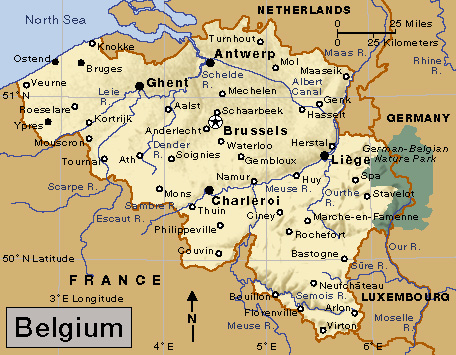
During most of its history, Belgium was a part of large, externally controlled empires. Ancient Rome, Spain, Austria, France, and the Netherlands ruled it at different times. In 1830, Belgium won its independence from the Netherlands and became united as a state.
Belgium has two main ethnic groups, a Dutch-speaking people called Flemings, who live in the north, and a French-speaking people called Walloons, who live in the south. Both French-speaking and Dutch-speaking people live in Brussels, Belgium’s capital. A group of German-speaking people live in eastern Belgium.
Belgium is an international center of economic and political activity. A number of international organizations have headquarters in Brussels, including the European Union and the North Atlantic Treaty Organization (NATO). Many international companies have branch offices or factories in Belgium.
Government
National government.
Belgium is a parliamentary democracy with a constitutional monarchy. The Belgian Constitution, adopted in 1831, makes the monarch the head of state. Executive power lies in the hands of the prime minister, who is the head of government, and the cabinet, called the Council of Ministers. The cabinet has an equal number of Dutch-speaking and French-speaking members. The prime minister and the cabinet members hold office as long as they have the support of the Belgian Parliament.
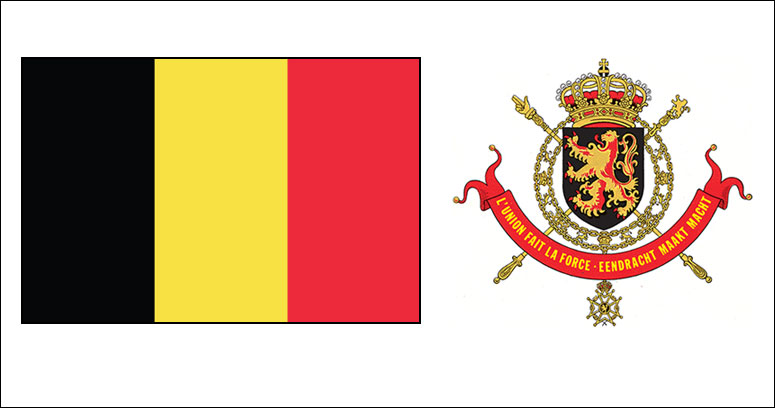
Belgium's national anthem
The Belgian Parliament has two houses, the Chamber of Representatives and the Senate. The Chamber has 150 members, directly elected by the people. The Senate has 60 members. Community and regional parliaments representing Belgium’s three language communities appoint 50 senators—29 from the Dutch-speaking community, 20 from the French-speaking community, and 1 from the German-speaking community. The appointed members select the remaining 10 senators. The members of Parliament have five-year terms. But the prime minister may request at any time that the monarch dissolve Parliament and call for new elections.
Regions and language communities.
Belgium is a federal state that has three regions, and it also has three separate language communities. The regions, which have a large degree of self-rule, are (1) Flanders, in the north, (2) Wallonia, in the south, and (3) the capital district of Brussels. The three language communities are (1) the Flemish community, which consists of people who speak Dutch; (2) the French-speaking community, and (3) the German-speaking community. 
Each of the three regions, Flanders, Wallonia, and Brussels, has its own prime minister and council of ministers and its own parliament, called the regional council. Voters elect members of the regional councils every five years. Each region has the power to make treaties concerning matters in its own area of responsibility. The regional governments control such matters as communications and public works. They also manage provincial and local governments and their financing.
Each of the language communities has a community council. The community councils are made up of members of the regional councils. The Flemish community council represents the Dutch-speaking population in Flanders and Brussels. The French community council represents French-speaking residents of Wallonia and Brussels. The German community council represents the German-speaking people in eastern Wallonia. These councils make decisions about culture, including language, museums, media, sports, and tourism. They also determine some policies in such areas as education and health and welfare.
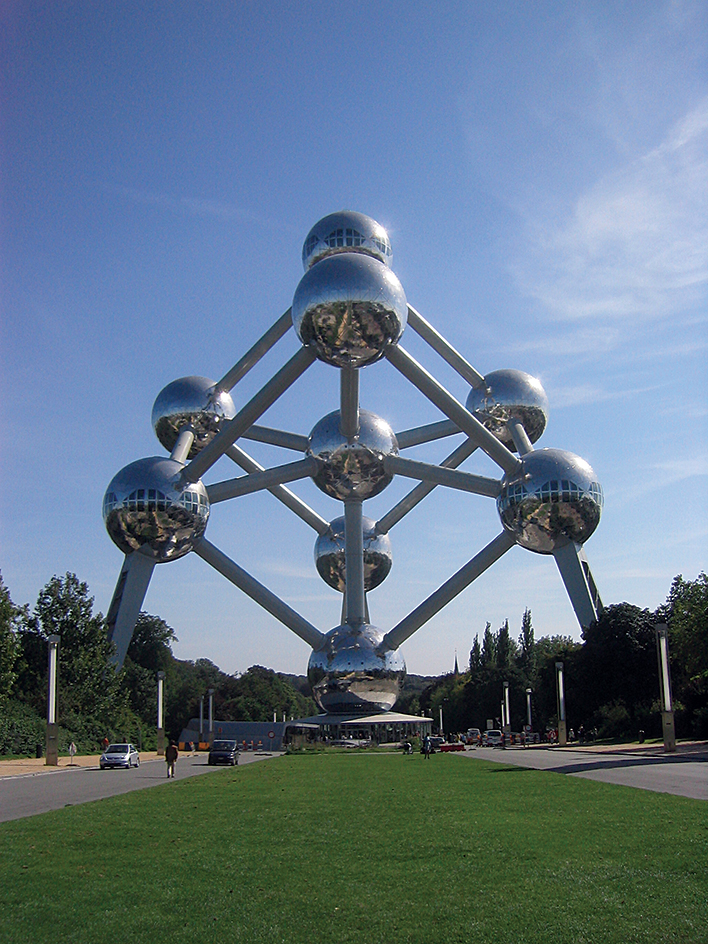
The local government system includes two more levels, the 10 provinces of Belgium and the communes (cities and towns), of which there are close to 600. Each province has a governor, appointed by the monarch, as well as deputies and provincial councils elected by the people. Each commune has a mayor, appointed by the monarch, and a council elected by the people. The council’s dominant political group nominates the mayoral candidate. Government in the provinces and communes takes care of such local matters as managing public property and providing law enforcement.
Politics.
Belgium has three major political groups. Each group has French- and Dutch-language parties. The two Socialist parties support an increase in social services for Belgian citizens. The Liberal parties favor limits on government spending and encourage private business. The Christian Democratic parties generally represent a moderate or middle position in politics. 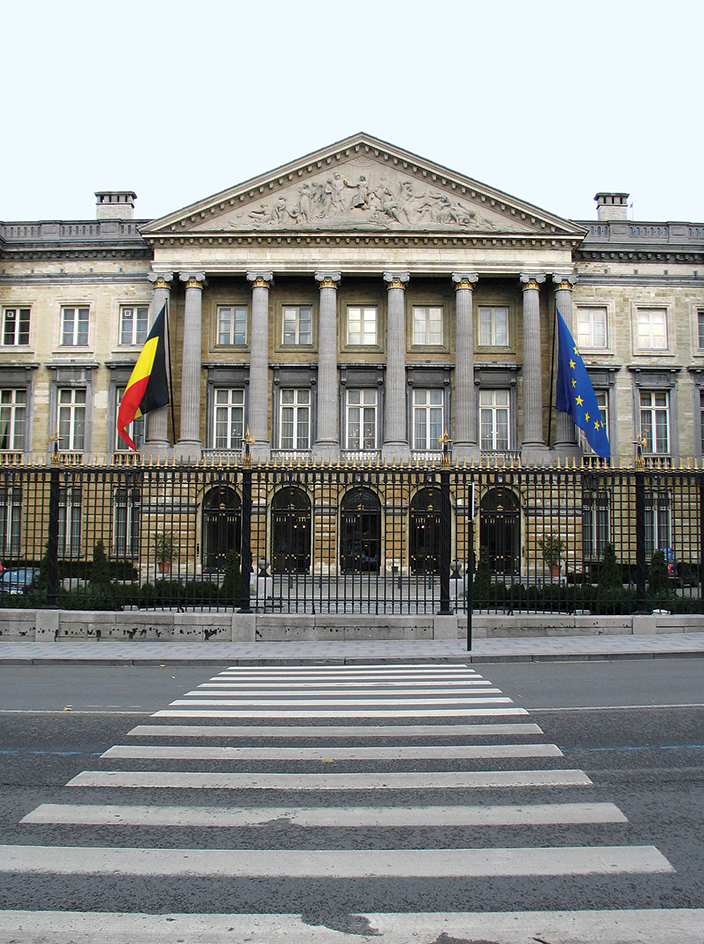
Belgium has many smaller parties. These parties represent regional, social, or economic concerns. A single party rarely is able to capture a majority, so parties must join forces and form a coalition (partnership) in order to gain control of the government.
All Belgian citizens who are 18 years of age or older must vote in national elections. Anyone who fails to vote may be fined.
Courts.
Belgium’s highest court is called the Court of Cassation. Five regional courts hear appeals of decisions made by lower courts. Special courts deal with such matters as labor disputes, commercial agreements, and military justice. An administrative superior court and a court of arbitration rule on conflicts between national and regional laws.
Armed forces.
Belgium has an army, navy, and air force. Military service is voluntary.
People
Population and ancestry.
Belgium is one of the most densely populated countries in the world. Antwerp is the largest city. Brussels is the capital and chief commercial center. With its suburbs, Brussels makes up the nation’s largest metropolitan area. Other major cities of Belgium are Bruges, Charleroi, Ghent, and Liège.

Almost 60 percent of Belgians are Flemings, and about 30 percent are Walloons. About 10 percent of residents are immigrants. The Flemish language and culture originated in what is now northern Belgium after a Germanic tribe called the Franks settled the sparsely populated region in the A.D. 200’s to 400’s. The Walloon culture developed in the south, which was densely inhabited by Romans and Celtic tribes when the Franks arrived. The Roman influence remained strong there, and the Franks were largely absorbed by the local culture. Some Belgians in the east-central part of the country, along the border with Germany, are of German descent.
Loading the player...
Belgian folk dance
Loading the player...
Belgian folk song
Languages.
Belgium has two official languages—Dutch, which is spoken by the Flemings; and French, which is spoken by the Walloons. The Belgian dialect of Dutch, previously called Flemish, now is referred to as Dutch. The official language for education and all public communication is Dutch in Flanders, French in Wallonia, and German in a tiny area of eastern Belgium. Both Dutch and French are used in the city of Brussels.
Way of life.
Most Belgians live in cities or towns. Many of them commute to jobs in other parts of the country. The European Union has its headquarters in Brussels. Foreigners have become an important part of the population. The Flemings and Walloons have cultural differences, but Belgians have been able to compromise. Their legal system balances the rights of the Flemings, the Walloons, and the residents of Brussels.
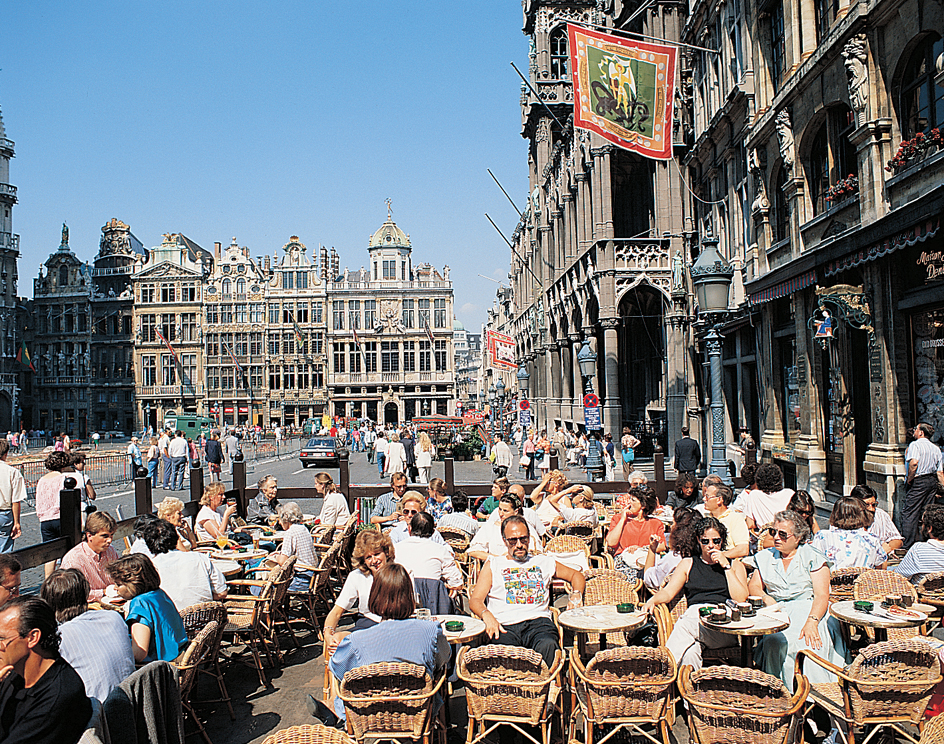
Bicycle racing and soccer are the most popular spectator sports throughout Belgium. On weekends, clubs of bicyclists of all ages ride through the countryside. Many Belgians vacation on the seacoast and spend short holidays in the Ardennes, a forested area in the southeastern part of Belgium.
Belgian cooking is famous. Two popular dishes are carbonnades (a beef stew made with beer) and waterzooi (a fish or chicken stew). Vegetable specialties include endive, leeks, and white asparagus. Belgian beers and chocolates are popular around the world.
Religion.
The Belgian Constitution guarantees freedom of worship. It also allows the government to grant financial support to all religions. About 60 percent of the people belong to the Roman Catholic Church, but less than 10 percent of them attend church regularly. However, many Flemings send their children to Catholic schools, and much Flemish political and social activity takes place in church-related organizations. About 1 percent of Belgians are Protestants, and many people claim no religion.
Education.
Almost all adult Belgians can read and write. The government funds both public schools and those operated by religious or other private groups. Educators praise Belgium’s progressive preschools. More than 90 percent of Belgian children attend them, beginning at the age of 21/2 years. Young people from 6 through 18 years of age must attend school.
Children from 6 through 11 years of age attend elementary school. After elementary school, all students attend comprehensive high schools. Students in these schools take basic courses, but each also specializes in technical, vocational, or college-preparatory subjects.
Belgium’s oldest university is the Catholic University of Louvain, founded in 1425. In 1834, members of a worldwide secret society called Freemasons (Masons), together with political liberals, established the Free University of Brussels. Both universities have two separate campuses for the two languages. Belgium established state universities at Ghent and Liege in the early 1800’s. In the last half of the 1900’s, a number of universities opened, including Antwerp for Dutch-speaking students and Mons for French-speaking students. The government pays 95 percent of the expenses of the universities.
The arts.
Many Belgians have made outstanding achievements in the arts, especially in painting. During the 1400’s, such Flemish artists as Jan van Eyck and Rogier van der Weyden painted with careful attention to detail. During the 1500’s, Pieter Bruegel the Elder painted colorful and detailed scenes of daily life. Sir Anthony Van Dyck became one of the greatest portrait painters of the 1600’s. Also during the 1600’s, Peter Paul Rubens painted works noted for their brilliant colors. Demons and weird human figures appear in paintings by James Ensor, a Belgian artist of the 1800’s. In the early 1900’s, Paul Delvaux and René Magritte created Surrealist paintings, which combine ordinary and dreamlike images.
The Flemish composers Johannes Ockeghem and Orlando di Lasso made great contributions to vocal music in the 1400’s and 1500’s. In the 1800’s, César Franck expanded the Classical style in his works for orchestra, organ, and piano. Adolphe Sax, a Belgian instrument maker, invented the saxophone about 1840. Jacques Brel was a famous French-speaking singer and songwriter from the 1950’s to the 1970’s.
Belgian literature includes two literatures, one in French and one in Flemish. During the 1800’s and early 1900’s, many of Belgium’s best writers, such as Charles de Coster and Maurice Maeterlinck, were Flemings who wrote in French. De Coster’s most famous work is the humorous novel The Legend of Ulenspiegel (1866) about the mischievous hero Till Eulenspiegel. Maeterlinck won the Nobel Prize in literature in 1911 for his plays, including The Blue Bird (1908) and Pelléas and Mélisande (1893). In the late 1800’s, many Belgians who wrote in French contributed to a magazine called La Jeune Belgique (Young Belgium). Some of them, including Camille Lemonnier and Emile Verhaeren, formed a literary group also called Young Belgium. In 1920, Jules Destree created the Royal Academy of French Language and Literature. Georges Simenon was a productive and widely read author of the 1900’s. He wrote detective stories and other fiction in French.
In the mid-1800’s, Hendrik Conscience became the first major Belgian author to write novels in Flemish. Guido Gezelle was the greatest Flemish poet of the 1800’s. The Flemish poet and novelist Hugo Claus is the leading Belgian writer in the Dutch language since the mid-1900’s. Louis-Paul Boon is a Flemish novelist who writes fiction based on actual events.
The land
Belgium has an extremely varied terrain for a small country. Several rivers are large enough to serve as important transportation routes. These rivers include the Schelde, the Sambre, and the Meuse (or Maas). Belgium has no large natural lakes, but engineers created lakes in the southern part of the country by damming rivers.

The Coastal and Interior Lowlands
extend across most of northern Belgium. Wide, sandy beaches lie along the 39-mile (63-kilometer) North Sea coast. As in the Netherlands, natural dunes and a system of sea walls and dikes protect the lowlands near the coast from flooding. These lowlands, called polders, form a humid, treeless plain crisscrossed by drainage canals.
Farther inland, the terrain becomes slightly rolling, with elevations as high as 300 feet (90 meters). The soil consists of a thin layer of sand over clay. However, the Belgians fertilize the soil and have made the region highly productive farmland.
The Kempenland,
also called the Campine, lies in northeastern Belgium. It was a thinly populated region of birch forests and marshland until coal was discovered there in the early 1900’s. Today, the region has industrial centers and nature areas for hiking. In addition, drainage has made the land suitable for growing rye and other cereal crops. Many of the birch forests have been cleared and replanted with fast-growing evergreens for timber harvest.
The Central Low Plateaus
occupy central Belgium. This region has Belgium’s best soils. It is also the site of many of the nation’s largest cities, including Brussels and Liege. The fertile valleys of the Sambre and Meuse rivers form the southern boundary of the Central Low Plateaus. 
The Ardennes
covers southeastern Belgium. A band of sandstone ridges and limestone valleys just south of the Sambre and Meuse rivers forms the northernmost part of the region. Farther south lie the woodlands of the Famenne, an area where rivers have carved numerous caves in soft limestone. The remainder of the Ardennes consists mainly of forest-covered hills separated by winding rivers. Botrange Mountain, the highest point in Belgium, rises 2,277 feet (694 meters).
The Ardennes is the least populated region and the least suitable for agriculture. Many deer, wild boars, and wild cats roam the forests of the Ardennes. Springs throughout the region are rich in minerals.
Climate
Belgium has a rainy climate with cool summers and mild winters. West winds blowing in from the sea bring the country much moisture and moderate temperatures. In Brussels, the temperature averages 35 °F (2 °C) in January and 64 °F (18 °C) in July. The temperature varies less along the coast and more in the Ardennes.
The coastal region averages 28 inches (71 centimeters) of precipitation a year. More than 40 inches (100 centimeters) fall yearly in the Ardennes. Snowfalls are common throughout the country, but snow seldom lasts long on the ground except in the Ardennes.
Economy
Belgium has a highly developed economy based on free enterprise—a system in which businesses operate with little government control. However, the government owns and manages parts of the country’s transportation and communication systems. It also provides basic social services and medical insurance coverage for all citizens.
Service industries
employ about three-quarters of Belgium’s workers. Hotels and restaurants benefit from the millions of tourists who visit Belgium each year. Most of the tourists come from France, Germany, the Netherlands, the United Kingdom, and other European countries. Many Belgians are employed by the government or in education, finance, health care, or retail trade. Belgium’s cities are the centers of most of its service industries. Brussels is a major European center of commerce, finance, and transportation.
Manufacturing
employs about one-eighth of all Belgian workers. Flanders is the leading manufacturing region. Steel-making is an important industry in Belgium. Belgium is among the world’s leading nations in per capita (per person) steel production. The steel industry was originally concentrated close to coal mines in Wallonia. But because the industry also uses imported raw materials to make steel, the newer steel plants lie near the ports in Flanders.
The Belgian chemical industry manufactures basic chemicals as well as pharmaceuticals (medicinal drugs). Food processing, including the manufacture of Belgian chocolates, ranks as an important industry. There are many breweries in Belgium, including some that are in monasteries. Many rough diamonds are cut in Antwerp. The city is the world’s largest diamond-trading center. Belgium also produces automobiles, cement, electronic products, machinery, and textiles.
Agriculture.
Farmers make up about 1 percent of the Belgian work force, but they produce most of the nation’s food. Farmland covers about half of Belgium’s land. Most Belgian farms are small and run by families.
Livestock farming is important to Belgium. Farmers raise beef and dairy cattle, chickens, and hogs. The main crops include barley, potatoes, sugar beets, and wheat. Belgium also produces large quantities of flowers, especially azaleas, as well as fruits and vegetables.
Mining
plays a small role in Belgium’s economy. Mining products include cobalt, dolomite, and limestone. The country’s once-productive coal mines all closed during the last half of the 1900’s because of high production costs and exhausted deposits.
International trade.
Belgium depends heavily on international trade, because the country has few natural resources and a small internal market for its finished goods. Belgium belongs to several international organizations that promote trade and economic cooperation. These organizations include the Belgium-Netherlands-Luxembourg Union, known as Benelux, and the European Union, an association of European countries. Belgium trades with many nations. About two-thirds of its trade is with other members of the European Union, especially France, Germany, and the Netherlands. Other important trading partners include China, India, Russia, and the United States.
Belgium imports about as much as it exports. Chemicals, machinery, motor vehicles, and pharmaceuticals make up a large share of both imports and exports. The country also imports food, petroleum, and rough diamonds. Other major exports include cut diamonds and steel.
Transportation.
Belgium has one of the densest railroad networks in the world. Zaventem International Airport, near Brussels, is a major airport. Antwerp ranks as Belgium’s chief seaport and is one of the busiest ports in the world. Ghent and Zeebrugge are important inland ports. There are about 1,000 miles (1,600 kilometers) of inland waterways that provide transportation for goods.
Communication.
Belgium has a number of daily newspapers. Most daily newspapers are published in either Dutch or French.
Radio and television stations are both publicly and privately owned. The public corporations broadcast in Dutch, French, and German. Cable TV programs come from several European countries.
History
People have lived in what is now Belgium since prehistoric times. During the 100’s B.C., Celtic tribes called the Belgae settled in the area. Roman forces led by Julius Caesar defeated the Belgae during the 50’s B.C. The area then became part of the region that the Romans called Gallia (Gaul). Roman rule brought the development of cities, local industries, and an excellent system of roads.
The Middle Ages.
By the later part of the A.D. 400’s, a Germanic people called the Franks had driven the Romans out of northern Gaul. Clovis, a Frankish king, founded a kingdom that included the Belgian region. The baptism of Clovis in 496 established Christianity as the state religion. During the late 600’s, the descendants of Clovis lost control of the kingdom to a family of Frankish rulers called the Carolingians. Charlemagne, the greatest of the Carolingians, ruled from 768 to 814. Under his reign, Belgium became the center of a large empire that covered much of western Europe.
In 843, Charlemagne’s three grandsons divided his empire among themselves into three kingdoms. By the 900’s, the Carolingians had lost much of their power. Local lords often provided land and protection to nobles in exchange for military and other services. Belgium became an important center of trade and industry over the following three centuries. In many towns, merchant guilds (associations) obtained town charters from their lords. The charters promoted the economic interests of the towns and granted numerous special privileges to merchants.
During the 800’s, the counts of Flanders emerged as strong rulers. By the 1000’s, other aristocratic families had established their own rule in territories that later became provinces. These included Brabant, Hainaut, Limburg, and Namur.
In 1302, a French army tried to enforce control over the Flanders area. Local peasants and skilled workers defeated the armored French knights. Every year on July 11, Flanders celebrates this victory as a public holiday.
Brussels and its surrounding area made up the duchy of Brabant. In 1354, when the Duke of Brabant needed money, he granted governmental powers to the church, the nobles, and the towns in exchange for taxes from the people. The document granting these powers is the Joyeuse Entree (Joyous Entry). It is similar to England’s Magna Carta. Its name refers to the official entry into Brussels in 1356 of the duke’s daughter, who had inherited the duchy after her father’s death. Upon her arrival in Brussels, she swore to uphold the agreement.
Towns and cities grew, especially in Flanders and Brabant. Bruges became a center of commerce. Ghent produced much of the cloth for Europe. By the end of the Middle Ages in the late 1400’s, about one-third of the people in the Belgian area lived in towns and cities.
Habsburg rule.
In 1477, the marriage of Mary of Burgundy and Maximilian of Austria brought the Low Countries (now Belgium and the Netherlands) under the rule of the Habsburg family of Austria. In 1506, their grandson Charles inherited the Low Countries. In 1516, Charles inherited Spain, and in 1519, he became Holy Roman Emperor Charles V. He was born in Ghent, and many of his advisers were from the Low Countries. In 1555 and 1556, Charles gave up the Low Countries, Spain, and Spanish territories to his son, who became Philip II of Spain. Charles’s brother Ferdinand received Austria and became Holy Roman Emperor.
Philip had fewer ties with the Low Countries than his father. He considered himself defender of the Roman Catholic faith, and he persecuted the Protestants in the Low Countries. He also tried to centralize the region’s administration at the expense of the local nobles and cities. In 1566, the Low Countries rebelled. In response, Philip sent the Duke of Alba from Spain with thousands of Spanish soldiers. The duke governed cruelly and imposed harsh new taxes. Many local nobles and Protestants left the region. William I, Prince of Orange, led the local forces that opposed the Spaniards.
The conflict lasted until 1648. Local forces held the northern part of the Low Countries, partly because their ships controlled the sea. The north, which later became the Netherlands, declared its independence in 1581. Spain finally recognized it in 1648. 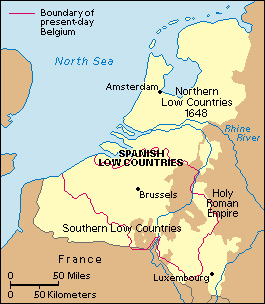
The local forces lost to the Spaniards in the south, which remained under Spanish control. The split between the north and south damaged the south’s economy. Trade decreased, partly because Flemish shipping was prohibited on the River Schelde from Antwerp to the sea. Also, many commercial leaders and artists moved to the new republic in the north. In the rest of the 1600’s, the area began to lose its economic strength.
During the second half of the 1700’s, Belgian farmers increased their productivity by growing new crops, especially potatoes, and by using better tools and such new farming techniques as crop rotation. Belgian industries also improved. The Ghent and Verviers areas produced textiles. The Liege and Charleroi areas developed and expanded mining and metal production.
The Brabant Revolution.
The Belgian area became an Austrian possession in 1713. From 1781 to 1787, Holy Roman Emperor Joseph II, who ruled Austria, tried to change the administrative, legal, educational, and judicial systems in the Belgian provinces. He ordered his own reforms, ignoring the protests of the local provincial legislatures. Led by two lawyers, Henri Van der Noot and Jan Vonck, the Belgians wrote a declaration of independence. In 1789, Belgian forces fought the Austrians and defeated them within three months in an uprising called the Brabant Revolution. In January 1790, the Belgians established an independent republic, the Etats Belgiques Unis, a federation of provinces modeled on the federation of states in the United States. Austria regained control of the area by the end of the year.
In the early 1790’s, French armies invaded Belgium and eventually drove out the Austrians. Belgium became part of France in 1795. The French ruled the area for 20 years. During that time, the French legal and educational systems replaced the existing systems, and the French language became dominant. 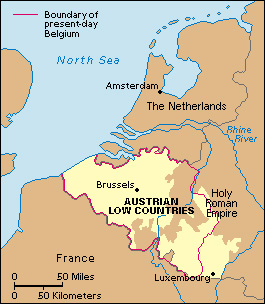
In 1815, France’s Emperor Napoleon I met his final defeat at the Battle of Waterloo in central Belgium. From late 1814 through early 1815, European political leaders met at the Congress of Vienna to remap the continent. They united Belgium, Holland, and Luxembourg into the Kingdom of the Netherlands as a barrier against future French expansion. Belgium’s economy grew rapidly under the union. But the Belgians became dissatisfied with Dutch government policies concerning education, language, and politics. Also, most Belgians were Roman Catholics and objected to the rule of Dutch Protestants.
Independence.
Opposition to the Dutch government grew, and the Belgians revolted in August 1830. On October 4, Belgium declared its independence. In December the major European powers—Austria, France, Prussia, Russia, and the United Kingdom—recognized Belgian independence. The next month, these countries signed an agreement guaranteeing the independence and neutrality of the new nation. 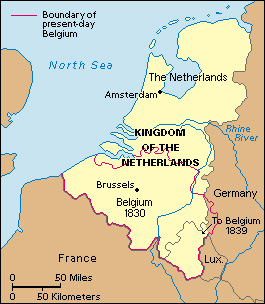
In 1831, Belgium chose as its king Prince Leopold of Saxe-Coburg and Gotha, whose niece later became Queen Victoria of the United Kingdom. The new country adopted a liberal constitution that guaranteed such rights as freedom of religion and freedom of the press.
Belgium was one of the first countries in Europe to industrialize. Coal and steel industries began in the south, but the north remained mainly agricultural. The government followed a free enterprise system in economics, and it did not regulate the early Belgian industries. In the 1830’s, Belgium became one of the first countries to build a railroad. The government soon developed a national railroad to connect the whole country. In fact, Belgium was one of the first countries to have a national railroad. Belgium greatly expanded its international trade during the remainder of the 1800’s.
In 1865, Leopold II succeeded his father as king. The new monarch wanted Belgium to possess a colony in central Africa. After the Belgian government refused to act, Leopold sent his own explorers to Africa. In 1885, the monarch established the Congo Free State as his private colony. The Congo supplied Belgium with rubber, ivory, and other valuable resources. However, the king’s agents treated the Africans brutally and refused to recognize African property rights to lands that the Africans held in common. Protests in Belgium, the United Kingdom, and the United States forced the king to surrender control of the Congo to the Belgian Parliament in 1908. The name of the region became the Belgian Congo.
Relations between the Flemings and the Walloons grew increasingly tense during the late 1800’s. Until that time, French-speaking people had largely controlled the government and the economy. The Flemings won recognition of Dutch as an official language in the late 1800’s. A series of laws passed in the 1930’s established equality between the two languages. However, conflict between the Flemings and the Walloons continued during the 1900’s as each of the two groups sought to advance its own economic and cultural interests.
The world wars.
The nephew of Leopold II became King Albert I in 1909. He led Belgium’s military forces during World War I. On August 4, 1914, Germany invaded Belgium and swept through the country into France. By late November, German troops occupied all of Belgium except a small corner in the northwest. The Belgian government went into exile in France. Nearly a million Belgians fled to the United Kingdom, France, and the Netherlands. The country became the scene of many bloody battles between the Central Powers, led by Germany, and the Allies, led by the United Kingdom and France. In September 1918, Allied forces began the liberation of Belgium, which became complete when the Germans surrendered in November.
The Treaty of Versailles, which officially ended the war with Germany, gave Belgium the German territories of Eupen, Malmedy, St. Vith, and Moresnet. Belgium also received control of the German East African region of Ruanda-Urundi (now the nations of Rwanda and Burundi). German payments for war damages and international aid helped the Belgian economy recover. The three Belgian political parties joined in a series of cooperative governments that worked to rebuild the economy and to secure diplomatic treaties.
Belgium again became a battlefield during World War II. German forces invaded the country on May 10, 1940. The Belgian army surrendered 18 days later. King Leopold III remained in German-occupied Belgium, but the Belgian cabinet moved the government to London. In September 1944, Allied forces liberated the country. In December, the Germans invaded southeastern Belgium, but the Allies repelled the attack and won a major victory at the Battle of the Bulge. World War II caused less physical destruction in Belgium than did World War I. However, the loss of life among civilians was much greater in World War II.
After World War II,
Belgium became one of the first countries in Europe to recover economically. However, Belgium faced a major crisis over what was called the “royal question.” Many Belgians bitterly criticized King Leopold III for staying in Belgium during the war. Some even accused the king of having cooperated with the Germans. In 1950, it appeared that Leopold’s continued reign would lead to civil war. He therefore gave the royal authority to his oldest son, who officially became King Baudouin I in 1951. Baudouin was a popular king. Many Belgians believe that he helped keep the country from splitting apart.
Belgium played a leading role in international affairs during the postwar years. It became a founding member of the United Nations (UN) in 1945. The next year, the Belgian statesman Paul-Henri Spaak served as the first president of the UN General Assembly. In 1949, Belgium joined 11 other nations in forming the North Atlantic Treaty Organization (NATO). Belgium was part of the movement toward European political and economic cooperation and helped to found the European Economic Community (EEC). This organization became part of the European Community and, later still, was incorporated into the European Union.
In 1956, the people of the Belgian Congo issued a declaration demanding thorough political change. The Belgian government granted only gradual and limited reforms. There was conflict in the Congo during the late 1950’s, and Belgium gave up the colony in 1960. In 1962, Belgium ended its supervision of Ruanda-Urundi.
After World War II ended in 1945, Flanders’s economy became stronger than Wallonia’s, reversing the trend of the previous century. In Flanders, high-technology industries began to develop. In Wallonia, the heavy industries founded in the 1800’s began to weaken. Tensions between the Flemings and the Walloons increased during the 1960’s. New political parties, mainly concerned with the controversial language problem, gained strength. In 1971, Parliament revised the Constitution to recognize three cultural communities based on language: a Flemish community, a French one, and a German one. The new Constitution also established three economic regions: Brussels, Flanders, and Wallonia.
The division among Belgium’s language communities hindered the cooperation needed to solve some economic problems. During the late 1990’s, the nation experienced high unemployment and a low rate of economic growth.
Recent developments.
In 1993, the government passed a law that officially made the country a federal state, consisting of the regions of Flanders, Wallonia, and Brussels. King Baudouin died in 1993. His brother became King Albert II.
In the late 1990’s and early 2000’s, Flanders experienced strong economic growth, but Wallonia faced high unemployment. The division among Belgium’s language communities continued to interfere with cooperation between the two regions.
In 1999, Guy Verhofstadt formed a coalition government and became prime minister. His coalition also won elections in 2003. In elections in 2007, Yves Leterme’s party won the most seats. After Leterme failed to form a coalition, Belgium entered a period of short-lived governments. Leterme’s government collapsed in 2010 in a dispute over the rights of Walloons in Flanders. Leterme remained in office, however, until a new government was finally formed in 2011. The Socialist Party’s Elio di Rupo then became Belgium’s first Walloon prime minister since 1974.
King Albert II gave up the throne in 2013, at the age of 79. His oldest son, Philippe, became king. In 2014, Charles Michel, the French-speaking head of the liberal Reformist Movement, became Belgium’s new prime minister and head of a coalition government. In 2016, Islamic terrorist bombings killed at least 30 people and injured more than 250 others at Brussels’ Zaventem airport and in the Maelbeek metro (subway) station.
After his government collapsed in December 2018, Michel continued as interim prime minister of a caretaker government. Michel was appointed president of the European Council, an institution of the European Union, in July 2019, and King Philippe named former budget minister Sophie Wilmès head of the caretaker government. Wilmès became Belgium’s first woman prime minister in November. In October 2020, seven parties formed a majority coalition government, and Flemish liberal Alexander De Croo succeeded Wilmès as prime minister. Wilmès became foreign minister.
Beginning in 2020, Belgium faced a public health crisis due to the COVID-19 pandemic (global epidemic). COVID-19, a contagious respiratory disease caused by a type of coronavirus, first broke out in China in late 2019. It soon spread around the world and caused outbreaks throughout Europe. Belgian authorities advised residents to practice social distancing and ordered many nonessential businesses to close. Belgium also limited travel at its borders. In May 2020, as infection rates appeared to decline, authorities allowed some shops, museums, and schools to reopen. Later in the year, and into 2021, authorities loosened or tightened restrictions based on the severity of local infection rates. The distribution of COVID-19 vaccines became a major focus of government efforts to fight the disease. In general, infection and death rates declined as vaccination rates improved. Highly contagious variants of COVID-19 led to further outbreaks, however. By early 2023, more than 4 million COVID-19 infections had been recorded in Belgium, and more than 30,000 Belgians had died from the disease.
